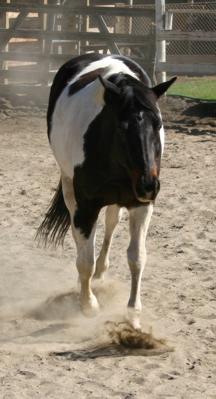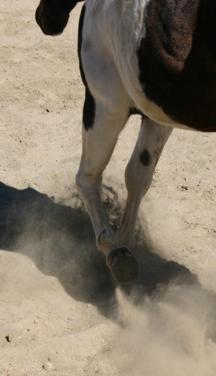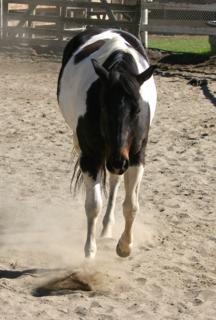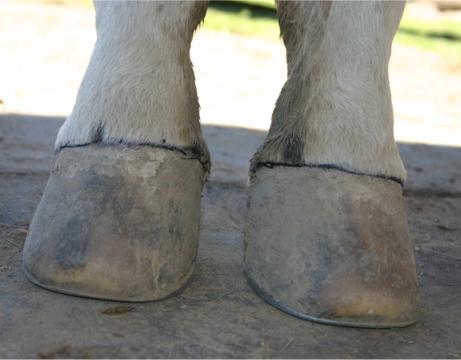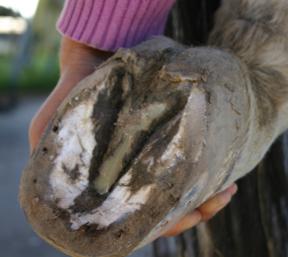 |
HealthyHoof.comHoofcare & Information for Barefoot SoundnessLinda Cowles Hoof Care - Serving the greater SF Bay Area and Northern California |
PromiseToe First Landings - See Update Page! |
|
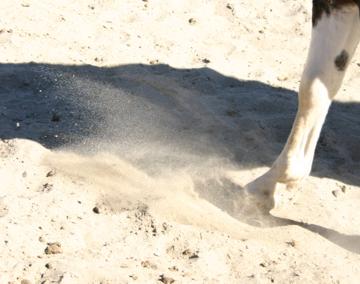 |
10/2005 Promise is a quarter horse mare whose tiny feet looked like they belong on a 12 hand pony. Part of the reason she has small feet is breeding, but some of the blame for her tiny hoof print can be attributed to the fact that her heels were over an inch too high. I have foot pictures below, but want to share some great shots of a toe-first landing. Promise's heels were painfully high, and as a result she tried to not use them., landing toe-first instead. Horses with sore heels get caught in a painful cycle because heel pain forces them to land toe-first. The more they use the toe, to more compacted and shorter it becomes. The less they use the heel, the less it wears and compacts. So the painful heel gets longer and causes more pain... These are pictures of Promises set-up trim... there are still some imbalances remaining, but we did as much as we dared to do in one session. I'll go back next Monday and touch her up.
|
Sound horses land heel-first , and Nina's description of her "stiff, bouncy canter" had me imagining high or sore heels even before I saw her feet. I asked Nina to get her moving in the arena so that I could observe her movement, thinking she was a "sound" horse, and realized she was almost as unsound as Leaguer. The best way to check for a toe or heel first landing is to walk or trot the horse on a dusty road or sand arena. As the toe lands in a toe first configuration. it scuffs dirt up in front of it. You can do this with your own foot; if you land toe first, your toe "dives" into the ground. If you land heel first, your foot rolls over the ground. It's a similar movement for horses. |
|
|
|
Do you have to constantly urge your horse forward? Check for Toe-First landings! Another characteristic of toe-first landing is noticeable when you are riding. It's the feeling that your horse is resisting moving forward. It's almost like he's going backwards even though the movement is forward, and it happens even on horses moving at speed, when it feels like the horse isn't picking his feet up or is scuffing his toes. The picture below shows poor Promise trying to canter... we'll show an After picture in a few weeks to document the difference. |
|
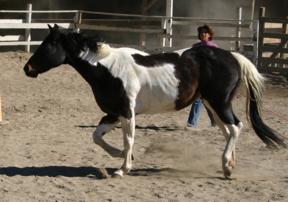 |
I remember this feeling guiltily, now, because this toe-first reluctance to move forward has, in the past, had me muttering angrily about the lazy horse I was riding, had me snapping "Pick up your feet!!!" and prodding my horse forward with every step... Now when I see people who have to ride with spurs, crops or who have to "peddle" their horse - encouraging the horse forward at each stride - I want to cry for these creatures whose pain and discomfort is so poorly misunderstood by the owners who often cherish them. Most sound horses with well fitting saddles love to move... if your horse won't move? Please get help figuring out why, and don't accept the easy answers... |
When I started assessing Promises feet, her high heel was extremely obvious. Using my rasp to remove the clinches on the shoes nails, I began seeing a blush of pink above the nail clinches and used the fine side of my rasp to remove the dirt from the wall, and discovered huge bruises above the nails in both front feet and one rear foot... no wonder this poor girl had such rough gaits! Another indication of heel discomfort was Promises short stride at a walk. This mare has a nice hip, loin and shoulder, her back is a nice length and she has a very nice conformation... her walk stride was very, very short.
|
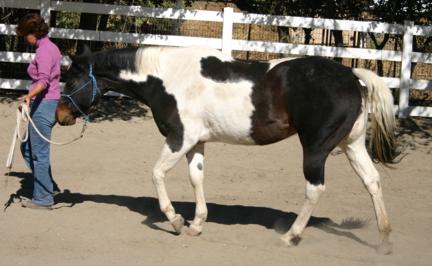 |
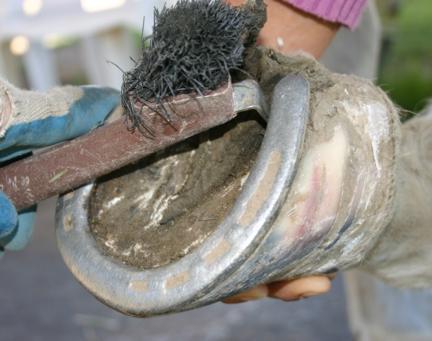 |
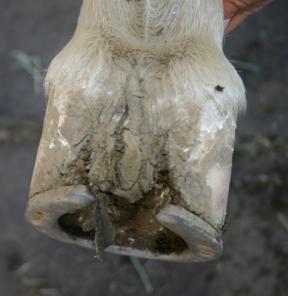 |
The pictures above document her extremely contracted and high heels, and the VERY deep collateral grooves... her farrier was simply too lazy to trim her heels. The bruising caused by the excess length is obvious on the shots of her front feet below, also. Her front right foot, shown below, was much longer that the front left, but not because the heel has a club conformation. This horse suffered from VERY poor farrier work, pure and simple. And the poor owner thought the highly recommended farrier was one of the best. This mare didn't fidget or pull, she stood quiet and was very willing, so this guy had NO excuses. Was he this sloppy because Promise is a child's horse? I want to show him these pictures and ask him, personally. We all make mistakes... this was the last set of mistakes he made with Promise.
|
|
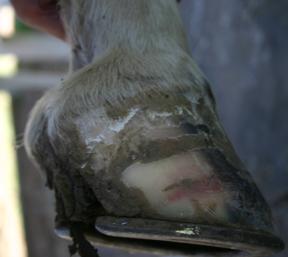 |
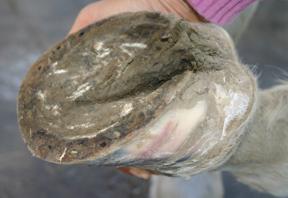 |
| I tried trimming the outside of her front right foot to show the before and after comparison because it was soooo extreme. I took this heel right down to the live sole (not into it) because of the bruising and because even then it would be too long. The sole was very crumbly and cleaned out easily with a knife. | |
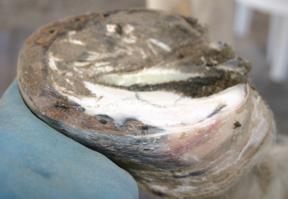 |
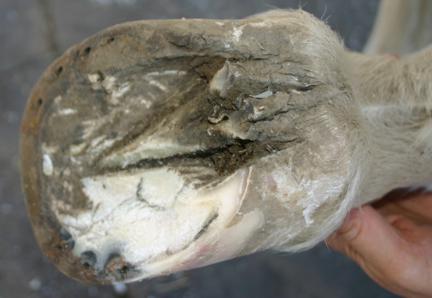 |
When I finished taking the heel down and shedding out the sole, the tiny foot showed it's potential to be large, and revealed a VERY long toe |
|
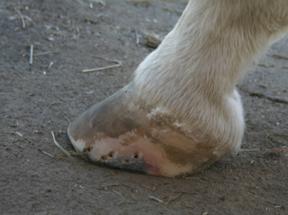  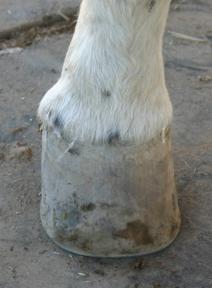 |
|
Promises Rear FeetAnother gait anomaly I noticed was that her rear legs collapsed or rocked outward as she weighted her rear feet. I asked Nina if she had a history of problems, and her response was that yes, the vet had suspected that she had both hock and stifle problems on both legs. |
|
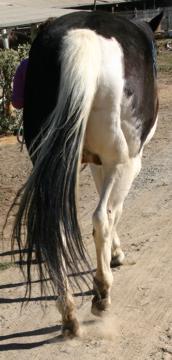 ...... ......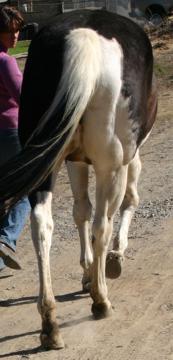 ...... ...... 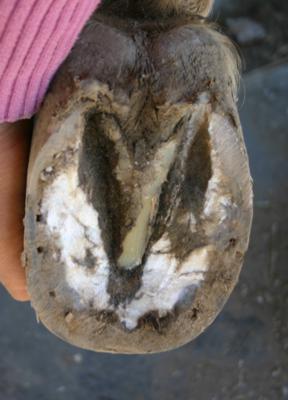 |
|
I had recently had a Foxtrotter whose rear end weakness was intensified - and potentially caused by - unequal wall lengths in the rear feet, so I immediately got down to ground level and examined Promises feet... could I fix her stifle and hock problem??? When The Best Tool You Have Is A Hammer, You Tend To See Nails As The Solution To Every Problem One of the people on the Yahoo Barefoothorsecare email list said that and it stuck... those of us with special skills try to use our skills to fix every problem we see! This is a good exercise, because sometimes we can deliver the solution... but I'm careful not to assume that the solution is mine!! In this case? I had, at least, part of the solution! Yea!!!! This had been an on-going problem, and the key was that the inside walls on both rear feet were a lot longer than the outside walls. It's common for inside walls to be slightly longer and straighter than outside walls, so perhaps it's easy for farrier's to discount length differences. When I looked carefully at Promises rear feet, they were longest on the inside toes, which caused her to toe out. They were also long on the inside heels, painfully long, and her gait indicates that she was collapsing to the outside in an attempt to not weight the long inside walls. When I checked her rear soles (to the right and above) , the outside sole buttress was strong and solid, and the outside bar was dense and overgrown... these conditions characterize lots of development driven by use. Her inside walls and bars were weak and flimsy, which characterizes avoidance. |
|
 |
|
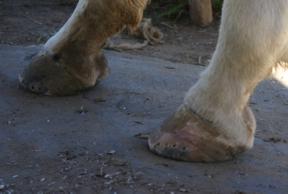 |
After the setup trimWe were delighted to see that Promises stride lengthened considerably after the trim... more importantly, she looked relaxed in the shoulders and across her ribs and top line. She walked around the arena at liberty, and looked extremely relaxed and comfortable. And then she laid down in the sun and took a nap! I like doing that after a good pedicure too. We couldn't ask for more! But we got it. As she moved across the arena, her stride from the rear showed improved use of her rear feet; she was tracking straighter, and that means the we may not have long term problems with her stifle and hocks... we can hope, can't we? |
Two days after the trimNina called me Wednesday, still thrilled with the improvements she'd seen with both Leaguer and Promise. She let me know that Promise was still moving soundly (I worried about tenderness in her front heels) and that she was moving very well in her paddock and arena. Nina, a retired nurse, is so impressed with the results that she's considering becoming a professional trimmer... |
|
Serving the greater SF Bay Area & Northern California
Home | Contact Linda | Privacy | About Us
